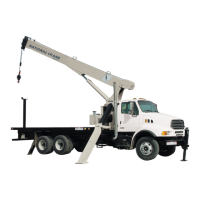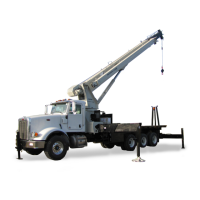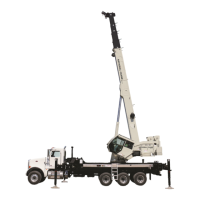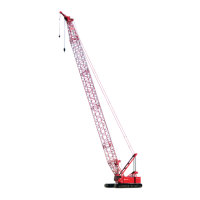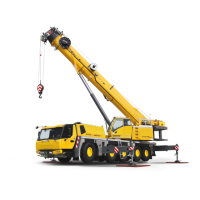3-8 07-03-19 Control # 091-09
CONTROLS AND OPERATING PROCEDURES OPERATOR MANUAL 600H SERIES
WORKING AREA
600 H-BC Working Area
The standard working area for the 600 H-BC is 180° with no
SFO. With a SFO, the work area is 360°.
600 H-RM Working Area
The standard working area for the 600 H-RM is 360°.
WORK SITE LOCATION
Select a location that is firm, level, and dry. Avoid uneven,
rocky or muddy terrain, steep grades, or locations with
overhead obstructions. The outrigger jacks must be
supported on a firm level surface at the fully retracted,
midspan, or fully extended positions. Avoid overhead power
lines.
Before Leaving the Truck Cab
• Position the truck so that the outriggers can be extended
with no obstructions.
• Put the truck transmission in neutral.
• Set the truck park brake. Wheel chocks may also be
required.
• Engage the power takeoff.
Before Making the Lift
• Set the outriggers as described in Section 4 Set-Up.
• Program the RCL as specified in the RCL Operator
Manual which is located in the document case.
• Check all controls for proper operation. If any abnormal
operations are detected, the condition must be corrected
before continuing.
• Check the work area for electric power lines.
LOAD CHART
Your unit is designed to provide satisfactory service if it is not
loaded in excess of the maximum rated loads specified in the
load chart. Overloading can create safety hazards, cause
structural damage, and shorten the service life of the crane.
You must understand how to use the load charts located in
the document case. Make sure the load, the working area,
and the crane configuration are within the load limit specified
in the load chart.
NOTE: Load handling devices (hook blocks and slings) are
considered part of the load.
Using the Load Chart
The following list is a definition of terms needed when using
the load chart.
• Load Radius — The horizontal distance from the
centerline of rotation, before loading, to the center of the
vertical load line or block. This distance is slightly
greater with an loaded boom due to deflection.
• Loaded Boom Angle — The loaded boom angle is the
angle between the first section boom and the horizontal
with the load. The loaded boom angle combined with the
boom length approximates the operating radius.
•Working Area — The area measured in a circular arc
above the center line of rotation to the suspended load.
NOTE: The standard work area for the 600H is 180°. With
a single front outrigger (SFO) the work area is
360°.
• Freely Suspended Load — The load hanging free with
no direct external force applied except by the loadline.
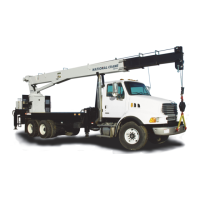
